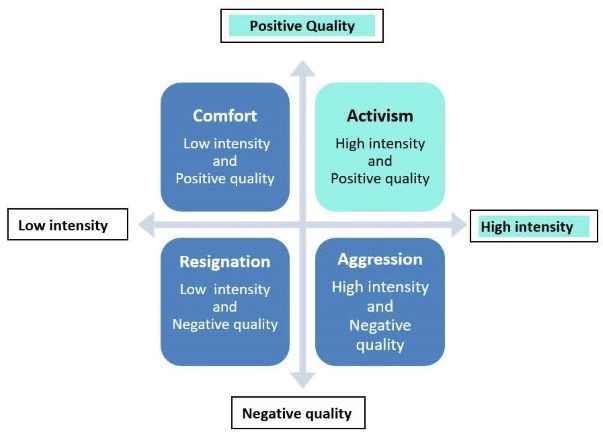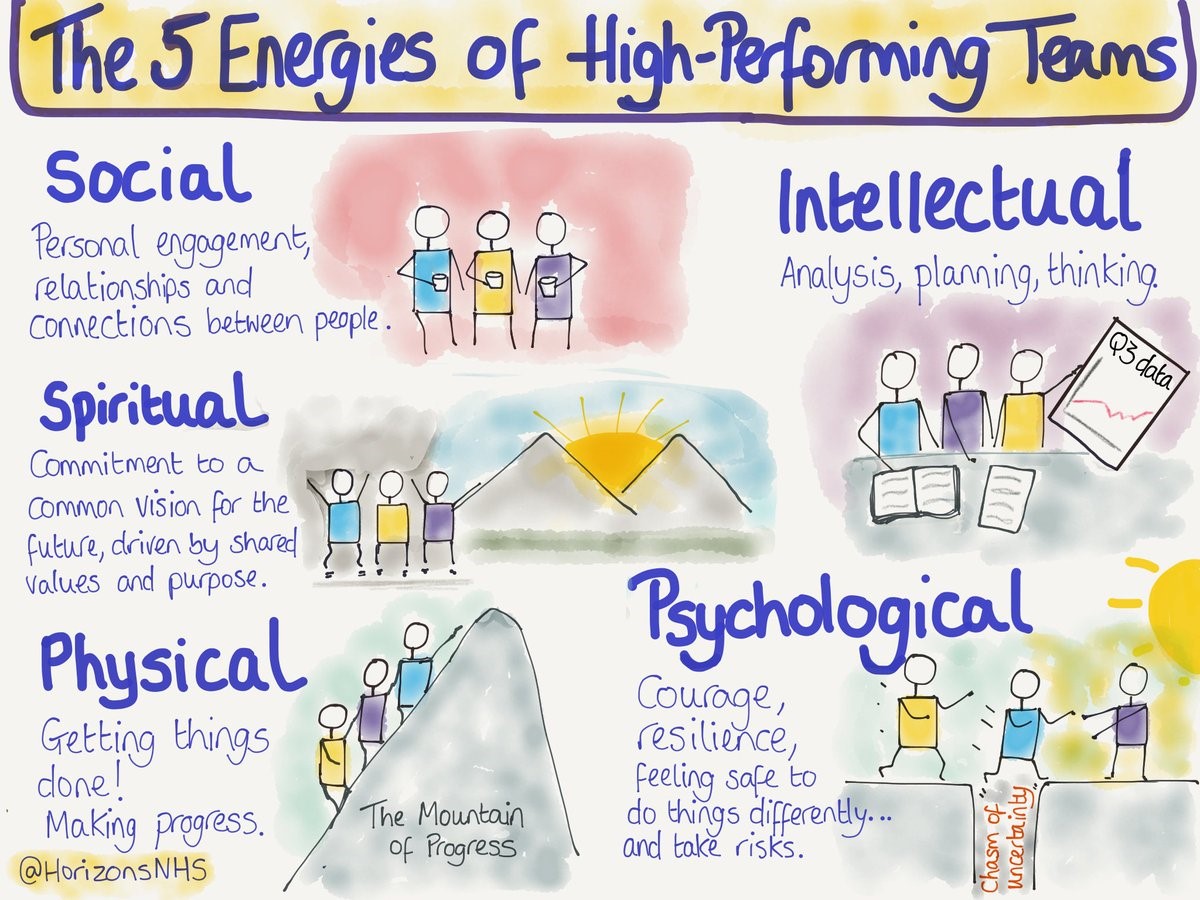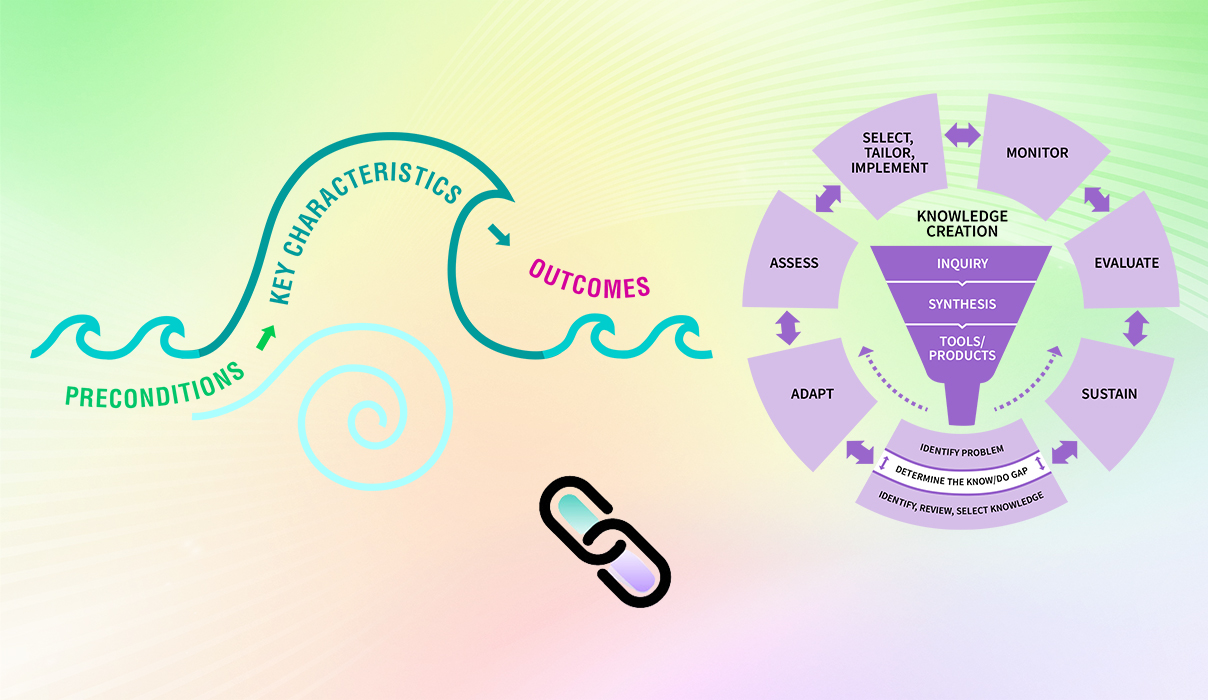Receptivity to change
- Receptivity to change
- 1 Why is this element important?
- 2 What is energy for change?
- 3 Determining the intensity and quality of the energy domains
- 4 Strategies to boost energy domains
- 5 Case study
- 6 Considerations for getting started
- 7 Linking this element to other framework components
- 8 More resources
Index
Social movements arise in settings that are receptive to change for a shared concern or desired change. In this section, you will learn about the multiple factors that influence receptivity to change, including domains of energy. You will also learn how to gauge the five energy domains in your setting, and what factors can enhance them.
This precondition happens when Individuals in an organization or other setting recognize an emerging shared concern or desired change, and interest and/or pressure for change is rising. There is a growing willingness to address the shared concern or desired change by using social movement actions.

Why is this element important?
- Receptivity to change is an essential precondition to organizing and taking individual and collective action. When present, there is an increased likelihood of success fueled by individuals’ support and engagement for the proposed change. The degree of receptivity for change indicates whether the change can move ahead and action begins (Sustainable Improvement Team and the Horizons Team, 2018).
- In settings where there is receptivity to change, change teams and change agents are starting to emerge as informal leaders moving a vision forward. In environments that lack receptivity, these people can be seen as "making trouble", promoting personal grievances or having unrealistic dreams; any attempts at leading change are quickly thwarted (Sustainable Improvement Team and the Horizons Team, 2018).
There are several concurrent factors that impact receptivity to change:
1. The proposed change
Impetus and motivation for change are growing in individuals who are inspired to take action and lead change in response to a shared or common concern or cause (Bate et al., 2004a; Bibby et al., 2009; Burbidge, 2017).
The proposed change or vision is supported by others and is seen as possible and feasible due to the availability of resources. This includes tangible resources (for example, time, budget and knowledge) and intangible resources (for example, encouragement, endorsement, support and help). When the vision is viewed as possible, people become motivated for the change and want to get involved (Albornos-Munoz et al., 2015; Bibby et al., 2009; Grinspun et al., 2010; Moreno-Casbas et al., 2010; Serna Restrepo et al., 2018).
2. The recognition of the limitations of traditional approaches to change
The limitations of traditional change models or hierarchical approaches for addressing a shared concern or desired change are seen. Top-down approaches to change are recognized as resulting too often in limited impact and sustainability. In contrast, the grassroots or "bottom-up" approach is valued; this results when the change is co-designed by those, directly and indirectly, involved with organizational support (Grinspun, 2018; Sustainable Improvement Team and the Horizons Team, 2018; Waring and Crompton, 2017).
Social movements are known for having the power to transform and effectively achieve change. There is evidence that applying social movement as a people-led approach to change can be transformative by mobilizing people to achieve goals or reinvigorate a change initiative (Bibby et al., 2009; Ruglis and Freudenberg, 2010; Yufang, H, et al, 2018).
3. The timing of the change
A timely and strategic opportunity for change is recognized. Examples of optimal timing for a change to happen include the following:
- when the change can be leveraged with other existing initiatives (MacDonald et al., 2018);
- when a new leader or leadership structure has been established;
- when a shift in thinking has developed, bringing an openness for new perspectives (Silva-Gallegillos, 2015);
- when financial and/or other needed resources are available; and
- when concerns voiced about a shared problem or desired change attract interest and attention, propelling the need and value for the change (Herechuk et al., 2010; Lippman et al., 2013; Ruglis and Freudenberg, 2010; Silva-Gallegillos, 2015).
4. The people engaged in the change
A setting’s social system and its dynamics are conducive to social movement actions. The scale and speed of a change initiative’s uptake are impacted by the social system. The social system is a part of the context that specifically focuses on groups of individuals (for example, a team, community, or organization) and their interactions (for example, their dynamics, behaviours or communications). It reflects the group’s values, trust, culture and norms.
In hierarchical social systems, a traditional top-down approach to change with managed and planned stages may be the accepted norm. Formal leaders are typically responsible for leading change initiatives and make decisions regarding staff’s role and scope of involvement. The work culture may be compliance-based, with staff expected to reach targets and other goals as determined by the formal leaders.
In contrast, social systems conducive to social movements are ones in which staff is encouraged and/or expected to lead change with organizational support. The organization embraces and values staff as informal leaders. This perspective recognizes that when staff owns and are committed to a cause, innovation and transformation through social movement approaches are both more likely to happen and to have a greater impact.
SOURCES: Bate et al., 2004a; Bibby et al., 2009; Grinspun, 2018; Rogers, 2003.
What is energy for change?
The energy for change reflects the ability and drive of individuals (for example, a group, team, or organization) to take action together and achieve collective goals. When the energy for change is present, it can fuel motivation and drive change initiatives forward.
Energy can be categorized into five domains: physical, psychological, social, spiritual and intellectual See the table just below for fuller descriptions of these domains.
Energy domains:
|
Energy type |
Description |
|
Physical energy |
This domain is about making people making progress, moving change forward and getting things done (that is, achieving goals). When present, it reflects an ability to be adaptable, flexible and responsive to change processes. |
|
Psychological energy |
This domain is about people having courage, hope, positivity, resilience and the willingness to take risks. Psychological energy is needed to do things differently in the face of challenges. When present, it reflects a high level of trust and support for informal and/or formal leaders and their vision for change. |
|
Social energy |
This domain reflects the relationships and level of connection and engagement between people. When social energy is high, people feel a sense of "we-ness" and engage in partnerships and collaborations. When social energy is low, an "us and them" culture can result and can threaten the group's coming together. An environment of openness, transparency and honesty regarding the change can boost social energy. |
|
Spiritual energy |
This domain reflects people’s commitment to the vision, shared values and purpose of the change. When present, it inspires and gives people the confidence to move beyond the current state and try to achieve new goals. It acknowledges that people’s commitment, satisfaction and focus are driven by what they collectively value the most. |
|
Intellectual energy |
This domain reflects people’s capacities of thinking, planning and analyzing. When present, it integrates logic and evidence to support change, direct processes and evaluate outcomes. |
SOURCES: Land et al., 2013; Sustainable Improvement Team and the Horizons Team, 2018.

SOURCE: NHS Horizons, NHS England, 2013. Used with permission.
The five energy domains are interrelated. They can support or oppose one another. There are no requirements for the amount of each domain needed to affect change; ebb and flow are normal.
For example, at the beginning of a change initiative, there may be high degrees of psychological and intellectual energies, but a low degree of physical energy amongst change teams, organizations, or systems. Individuals may have the courage to make a change and begin to think about and plan for the change initiative; however, there may be little progress at this stage of change.
In settings using social movement actions, the necessary domains of energy include:
- Psychological energy must be strong so that people feel safer to take risks and try new and innovative approaches that may or may not succeed. Psychological energy can be strengthened by increasing the spiritual and social domains of energy.
- Physical energy is needed to help people feel confident in their ability to progress and achieve change, based on previous experiences.
- Social energy must be high to fuel the collaboration needed to mobilize or come together for change.
In contrast, settings using traditional, structured top-down approaches to change tend to have the following levels of energy domains:
- Intellectual energy is high, reflecting change efforts that use logical and rational planning. This keeps leaders in their "comfort zone".
- Physical energy is characterized in terms of the progress made and whether goals were reached.
- Social, spiritual and psychological energy domains are lower; at most, a sense of shared purpose is minimally expressed.
SOURCES: Land et al., 2013; Sustainable Improvement Team and the Horizons Team, 2018.
Determining the intensity and quality of the energy domains
Examining the intensity and quality of the five energy domains may help gauge the appetite for social movement action. Each energy domain can be assessed for:
- its intensity (low to high);
- its quality, whether negative (for example, where there is doubt, anger, skepticism, fear or blaming present] or positive (for example, where there is hope, courage and faith present).
There are four possible outcomes: comfort, activism, aggression and resignation, as shown in the graphic below.
The intensity and quality of the energy domains

SOURCE: Land et al., 2013.
Remember: Social movements need the energy of Activism = high intensity (that is, a high level of engagement or involvement to fuel the change) + positive quality (that is, motivation, altruism and excellence) energy domains
Examples of enhancing and depleting sources of energy for each domain of energy
|
Enhancing energy sources energy sources |
Domains of energy |
Depleting energy sources |
|
Relationships amongst groups that are authentic, engaged, empathetic, autonomous, and that have a high level of emotional awareness |
Social |
Relationships that are characterized as disconnected, lacking connection, apathetic, isolated, or fearful. |
|
Purpose; co-creation; integrity; passion; commitment; clear vision |
Spiritual |
Conflicts; coercion or use of buy-in; crisis; lack of belief in purpose |
|
Motivation; awareness; confidence; aspiration; safe environment; purpose; role models; resilience; determination; trust |
Psychological |
Fear; apathy; lack of trust; setbacks; fatigue; bullying ; resistance; compliance; lack of caring about the change |
|
Healthy people; regular renewal; appropriate and safe staffing and workload |
Physical |
Stress; being overworked; disconnection, exhaustion |
|
Learning; opportunities for professional development; purpose; focus; challenge |
Intellectual |
Being overworked; lack of discipline; distractions; "reinventing the wheel" |
SOURCE: Land et al., 2013.
Strategies to boost energy domains
We outline strategies for boosting the five energy domains in the table below.
|
Domains of energy |
Suggested strategies to raise energy domain |
|
Social |
|
|
Spiritual |
|
|
Psychological |
|
|
Physical |
|
|
Intellectual |
|
SOURCE: Land et al., 2013.
Here is an example of a campaign used to raise social energy to boost teams in a change initiative:

Shared with permission from Renfrew Victoria Hospital
It can also be helpful to understand how the five energy domains when in balance, can support change teams and change agents to be effective in leading change initiatives, as depicted in the graphic below (NHS Horizons, NHS England, 2011).

Accelerate your success: The Knowledge-to-Action Framework’s "Adapt knowledge to local context" action cycle phase includes a discussion of the multiple contextual factors and their interacting effects on the uptake.
Case study

The Alabama Comprehensive Cancer Control Coalition
In Alabama, United States, a public health community coalition targeting breast and cervical cancer prevention engaged in grassroots advocacy to influence policy and legislation for smoke-free spaces (Wynn et al., 2011).
This coalition was made up of local stakeholders, including an interdisciplinary committee of government officials, faith-based organizations, academics, researchers and volunteers. Their collective efforts were effective in part because the people involved were receptive to change.
There was a strong impetus for change caused by these concurrent factors:
- data showing an unequal burden of cancers among Black Americans due in part to higher rates of tobacco use and second-hand smoke exposure.
- recognition that the risk of cancers could be lowered by: implementing evidence-informed strategies; increasing public awareness and advocacy; and promoting healthy public policy.
- the coalition’s commitment to creating social change by improving the health and well-being of the community to achieve positive health outcomes.
- public support for the establishment of legislated smoke-free areas, evident from the results of local and national Gallup polls.
- an understanding of the powerful impact of social movement actions to create change.
This receptivity to change led the coalition to engage in social movement actions. They became empowered by learning strategies to lead change; they realized the power of their collective voices and mobilized actions. They felt their actions were timely and needed due to the data indicating rising cancer levels amongst Black Americans. They were committed to taking action to address and rectify health inequities.
Considerations for getting started
To start assessing your setting’s receptivity to change including all of the multiple concurrent factors, you and your change team can consider the following strategies:
- Determine the areas of strength and the areas where further attention is needed. This will help create the strongest starting point for a change initiative.
- Examine previous change efforts and lessons learned to inform areas of strength and limitations.
- Share your insights with others to begin a dialogue about the proposed change. Listen carefully to other’s feedback, concerns and perception of the change. This insight can be very powerful as others can get involved in the early phases of the change initiative.
- Strive to have the necessary resources available – both tangible and intangible.
- Share endorsements for the change with others in public domains, such as group email, intranet or social media platforms. This can increase awareness and credibility.
- Make time to get feedback from those beyond the change team. By listening to their ideas and concerns, and being open to making revisions to your plan based on what they say, you can delay or thwart resistance and threats to momentum in achieving your goals.
- Engage the energy of early adopters who are willing to get involved and trust that with time and momentum, others will also become engaged.
SOURCES: Land et al., 2013; Sustainable Improvement Team and the Horizons Team, 2018.
Linking this element to other framework components

Elements of the Social Movement Action (SMA) Framework are dynamic and interrelated. For example, a receptivity for change can be linked to the other two preconditions: "Change is valued and necessary" and "Examples of social movements are recognized". When change is valued and necessary, individuals are motivated to start getting involved in the change; this can support "Activism" energy of high intensity and positive quality. When examples of social movements are recognized, it can inspire and motivate others to take a people-led approach to change. This too can increase receptivity for using social movement actions.
Linking to the action cycle phases of the Knowledge-to-Action Framework
You and your change team’s capacity in social movement actions may be enhanced or accelerated by adding in some of the action cycle phases of the Knowledge-to-Action (KTA) Framework, as the two frameworks are complementary. In addition to the two linking examples described earlier in this section, there can be many other points of connection between the two frameworks. Here are three examples for you to consider:
- Identify the problem: Once receptivity to change for a shared concern or desired change is recognized, you and your change team can use the KTA Framework's "Identify the problem" phase to clearly determine the issue or issues you would like to address. In this phase, you can perform a gap analysis to identify problems or practices that can be feasibly addressed in your setting.
- Adapt knowledge to local context: An understanding of the context will help you decide whether there is an opportunity for change. To ensure that the identified problem can be addressed effectively, you and your change team should consider contextual factors such as 1. whether the nature of the leadership culture is formal or informal; 2. which resources are available to effect the change; and 3. who will effect the change or be affected by it?
- Assess facilitators and barriers: Identify and assess the facilitators and barriers that will help or hinder the change. This will help you and your change team decide whether there is receptivity to change for a shared concern or desired change.
- For more discussion about the dynamic links between the elements of the SMA Framework to one another and to the KTA Framework, see the section "Two complementary frameworks".
More resources
|
Name of resource |
Description |
|
This resource describes the benefits of psychological safety and how it contributes to learning and innovation. It presents some steps to building psychological safety, including framing change as a learning problem in times of uncertainty. |
|
|
Building and aligning energy for change (Land, Hex, Bartlett, 2013) |
This resource covers the five types of energy. It covers initial concept testing to measure each energy type, as well as related concepts and the theory. |
|
From compliance to commitment: build energy for change (Land, Hex, Bevan and Hunt, 2014) |
This discussion paper addresses the domains of energy, and how to use an assessment of the five types of energy to raise the level of commitment to change. |
|
NHS Energy for change animation (NHS Horizons, NHS England, 2013) |
This video on the role and impact of energy shows how energy has the power to fuel change by individuals and teams, as leaders united by a common goal. |
|
This book and presentation by Simon Sinek describe an approach to change that emphasizes an individual’s purpose (or the question "Why?") as a driver for action. |
